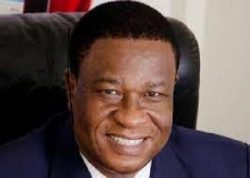The thought came to me a junction too late. I had miscalculated the drive time and underestimated the traffic at that time of the day. I just could not turn the car and head back home. Doing so would have meant being late for my appointment and that is the last thing you want when you have a presentation to do to a Board of Directors. But oh how I really wanted to go back for that particular item. It would have been the highlight of my presentation that late morning.
I could just picture the looks on the faces of those distinguished Board members. To see a miniature chair right in the middle of that huge mahogany table inside the Boardroom would have captured their attention like no other prop would have. Suffice it to say, the meeting went well, although throughout the entire presentation I felt there was something more I could have done.
But where did I get the idea to attempt to pull off that outrageous stunt? Like many other things, I read it somewhere on the Net and I fell in love with the whole idea. It is this popular story about Amazon founder and current world’s richest man, Jeff Bezos. It is said that he had a practice of leaving one empty chair around the Boardroom purposely to represent the most important person in the meeting—the customer. There are some narratives that claim that this Empty Chair Rule applies to every important meeting inside Amazon, not just Board meetings.
For a Service Excellence Consultant, that story so resonates with me. I see it as one of the best ways that I can employ to bring home a message I have been trying to get people to accept for more than a dozen years now—that the customer is most important person in the entire organisation, including in the Boardroom. I have been thinking of other ways or props one can use to pull of this particular stunt, besides an empty chair or a miniature chair. I have been considering how apt a mannequin or a life-sized image of a human would be.
Very few would argue about the power that a Board of Directors in the grand scheme of things for any organisation, especially one that is properly constituted and has power to perform. The Board can hire and fire the big boss. The Board can halt operations of the organisation for a period of time, when it feels the need to. The Board can, by a single decision, even change the direction of the whole organisation. It is common knowledge that the Board is not to be toyed with.
However, the truth is that there is another entity that has the same powers as, if not more than, the Board. This entity can hire and fire the big boss, even if indirectly. This entity can halt operations of the organisation, when it feels the need to. This entity can, by a single decision, even change the direction of the whole organisation. Beyond all these, this entity has the enviable power of being able to fire the entire Board. It is this powerful entity that Jeff Bezos was said to represent at each Board meeting. This entity is none other than the customer—the one entity that can match the Board of Directors boot for boot.
If one careful considers the power these two entities wield, it makes sense that when the Board meets, the customer should be there. Board meetings, more often than not, are so concerned with the bottom-line that they sometimes tend to forget the importance of the customer. It is not that CEOs do not know how important the customer is to the survival and success of the business.
A 2017 survey of CEOs by global tax and audit giant PriceWaterhouseCoopers (PwC) revealed that 80% of CEOS globally carry out philanthropic activities mainly to build trust with customers. The study also revealed that 84% of global businesses use an inclusivity and diversity policy for building trust with customers. 2014’s Conference Board survey of CEO also revealed that customer relationship was the second most important challenge facing CEOs all over the world.
All these findings prove that those at the top know that the customer is very important. They know that we are actually in the Age of the Customer. There are some companies that have been able to successfully place the customer at the centre of its decisions. Companies such as Nevada, US-based online shoe and clothing retailer Zappos and Washington, US-based American luxury department store chain Nordstrom are two of those customer-centric businesses. It is little wonder that these genuinely customer-centric companies are mostly industry leaders.
It is one thing to pay lip service to the concept of bringing the customer’s views into the very important meetings. But it is a totally different to carry out policies that make the customer’s views a part of the day-to-day operations of the organisation. In my experience, the key to making an organisation truly customer-centric is to have a CEO who is truly customer-centric.
This is because of the vital role the Chief Executive plays between the Board and the organisation. A Chief Executive who understands customer service like Mr. Bezos is a blessing for customer service. Such a CEO is able to not only make a case for the customer at the very top but is also in the position to come down and put the recommendations into action. Because customer-centric initiatives might require some expenditure, it is important that the one who has the power to sign the cheque is there when the decision is made.
I am not even sure if the Jeff Bezos story is really true or not—because it is something only Amazon insiders would be able to confirm. However, if one is to consider some comments that Mr. Bezos has made over the past, then that Empty Chair Rule seems very plausible.
The following quote is one of numerous customer-centric quotes attributed to him.
“We see our customers as invited guests to a party, and we are the hosts. It’s our job every day to make every important aspect of the customer experience a little bit better.”
Then there are these other quotes attributed to Mr. Bezos.
“In the old world, you devoted 30% of your time to building a great service and 70% of your time to shouting about it. In the new world, that inverts.”
“You know if you make a customer unhappy, they won’t tell five friends, they’ll tell 5,000 friends. So we are at a point now where we have all of the things we need to build an important and lasting company, and if we don’t, it will be shame on us.”
There is one particular story that makes me believe that Mr. Bezos will easily do something like the Empty Chair stunt. There is a story about an executive meeting that Mr. Bezos held some years back that tells you everything you need to do about the man. It is reported that during the meeting, the CEO asked Amazon’s first Worldwide VP of Customer Service, Bill Price how long customers were made to wait when they called the customer service hotline. Mr. Price was said to have told Mr. Bezos that customers were made to wait for about a minute.
It is said that Mr. Bezos, right there and then, decided to test the truth of that claim right there and then. The report said that there was visible tension as the hold went pass the one-minute and two-minute marks. We are told it took more than four minutes, something which really got Mr. Bezos very upset. A CEO who can get upset over how long it took customers to hold before they got through to someone is one who is definitely serious about customer service.
But regardless of the veracity of the Empty Chair Rule, it is a great way to get the message of the importance of the customer’s viewpoint right to the very highest making body in any organisation. The Voice of the Customer (VoC) must be heard and heard audibly in the Boardroom and in every other important meeting throughout the entire organisation.
There are some organisations that have made it a practice that at every board meeting, there is at least one real-life customer story that is shared for every board member to know what it actually happening in the organisation. I believe getting the VoC right at the centre of the Board’s decisions are important because, in my experience, many board members are a bit far from the action on the ground so some times their decisions do not reflect the reality on the ground.
It is my prayer that every manager, supervisor, head of department or executive reading this piece would find great ways of ensuring that at every important meeting in the organisation something reminds every one present of the customer. If the one cannot find any prop or object to represent the customer, there is always Mr. Bezos’ empty chair.










